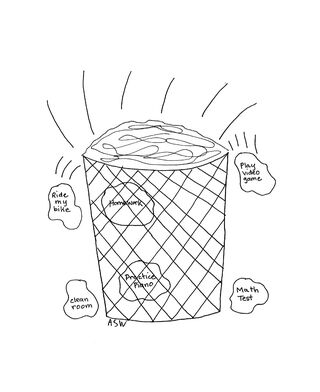ADHD
Lessons I Learned Raising a Son with Inattentive-Type ADHD
Personal Perspective: Raising a successful child with inattentive ADHD.
Posted April 22, 2022 Reviewed by Tyler Woods
Key points
- What does inattentive-type ADHD look like in boys?
- The negative symptoms of ADHD often interfere with performance in school.
- Learning to work with your child's ADHD brain is important.

“My brain is an overstuffed garbage can the lid doesn’t stay on, and stuff is falling out all over the floor.” This is how my son describes what it is like to have inattentive-type ADHD.
But wait a minute! Inattentive-type ADHD usually affects girls and adults. If my son had ADHD, why wasn’t he running around the classroom being disruptive? Boys are three times more likely to be diagnosed with ADHD due to the presence of hyperactive and impulsive behaviors compared to girls, who predominantly display symptoms of inattention. Not my son. He would quietly disappear to the bathroom or the nurse’s office in school to avoid assignments only to end up in the principal’s office to complete the pile of worksheets stuffed in his desk.
ADHD can make it difficult to show what you know
Despite his ADHD, my son did well in elementary school, even receiving a national award for excellence in math in the fifth grade. In fact, research on ADHD symptoms and academic performance suggests that inattention and intelligence are unrelated, and some children with ADHD are considered twice-exceptional due to their intellectual giftedness combined with a diagnosis of ADHD. However, in middle school, everything came crashing down and my son’s ADHD brain just couldn’t keep up with the increasing number of assignments. Executive functioning, the neurological process important for planning and initiating tasks, time management, organization, and emotional control, is impaired in ADHD. My son’s ripped, overstuffed folder for school was held together by random strips of duct tape, his planner was filled with doodles instead of homework assignments, and his backpack was a sea of crumpled papers.
Although my son had a 504 plan, I still felt the need to send emails to his teachers to make sure they understood his limitations as well as his talents. I found most teachers receptive to my relentless communications, however there were a few who misunderstood his inattentive ADHD and pigeonholed my son as lazy and disinterested in school. Unfortunately, the inattentive subtype of ADHD continues to be misunderstood and underdiagnosed, particularly in boys who are not hyperactive but inattentive, disorganized, and forgetful.
Learning to work with an ADHD brain
Raising a successful child with inattentive ADHD is no small task. I remind myself often that ADHD is a neurobiological disorder and my son is not choosing to fail classes in school, be disorganized, or have uncontrollable emotional outbursts. Learning and understanding that my son’s brain did not work like mine was a huge step in helping him to manage his ADHD over the past nine years. For example, having a child with ADHD whose idea of organization is a big pile on the floor has been a bit of a challenge for me. After several failed attempts to contain his chaos, I finally realized I needed to enlist my son’s help to find a solution that works for him and not one that works for me.
Having a child with inattentive ADHD forced me to change my perception of what I thought I knew. ADHD is not just negative symptoms that need to be treated, but ADHD characteristics like creative thinking, hyperfocus, and risk-taking contribute to unique problem-solving skills and are known characteristics of entrepreneurs. I admire my son’s fearless, bold action; he will dive head-first into the unknown without worry. My son has shown me the importance of living life to the fullest.


